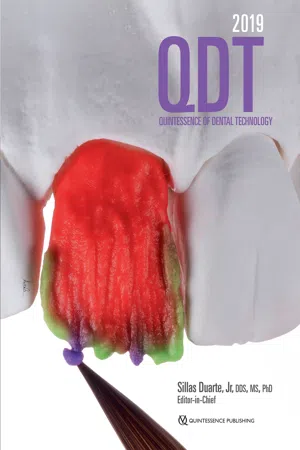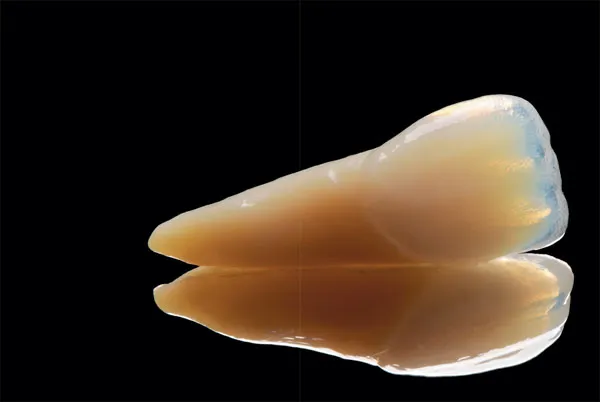
This is a test
- 232 pages
- English
- ePUB (mobile friendly)
- Available on iOS & Android
eBook - ePub
Book details
Book preview
Table of contents
Citations
About This Book
QDT 2019 presents a potpourri of original articles highlighting new techniques and novel approaches for creating beautiful smiles—both in form and function. Featured articles include an innovative procedure for predictably matching a veneer to an implant crown, a program for producing a personalized smile based on its visual identity, and the Plane System for virtual functional and esthetic analysis, diagnosis, and CAD/CAM fabrication. These are but a few of the pearls found in this year's beautifully produced annual resource for the dental technician and restorative clinician. 1, 000+ illus
Frequently asked questions
At the moment all of our mobile-responsive ePub books are available to download via the app. Most of our PDFs are also available to download and we're working on making the final remaining ones downloadable now. Learn more here.
Both plans give you full access to the library and all of Perlego’s features. The only differences are the price and subscription period: With the annual plan you’ll save around 30% compared to 12 months on the monthly plan.
We are an online textbook subscription service, where you can get access to an entire online library for less than the price of a single book per month. With over 1 million books across 1000+ topics, we’ve got you covered! Learn more here.
Look out for the read-aloud symbol on your next book to see if you can listen to it. The read-aloud tool reads text aloud for you, highlighting the text as it is being read. You can pause it, speed it up and slow it down. Learn more here.
Yes, you can access Quintessence of Dental Technology 2019 by Sillas Jr. Duarte in PDF and/or ePUB format, as well as other popular books in Medicine & Dentistry. We have over one million books available in our catalogue for you to explore.
Information
Additive Manufacturing: Applications in Dentistry Based on Materials Selection

Josef Schweiger, CDT, MSc1
Johannes Trimpl, CDT2
Clemens Schwerin, MDT3
Jan-Frederik Güth, PD Dr Med Dent4
Daniel Edelhoff, Prof Dr Med Dent, CDT5
Johannes Trimpl, CDT2
Clemens Schwerin, MDT3
Jan-Frederik Güth, PD Dr Med Dent4
Daniel Edelhoff, Prof Dr Med Dent, CDT5
Today, “3D printing” is commonly used as a synonym for all additive manufacturing processes. However, specialists consider this to be a misuse of the term, since 3D printing refers to a specific technology that belongs to the broader field of additive manufacturing.1 Indeed, when looking closely at 3D printing, it becomes clear that only a small part of all additive processes is covered.2,3
A clear classification can be found in the VDI guideline 3404, published by the Association of German Engineers (Verein Deutscher Ingenieure), or in the ISO/DIN 17296 standard. Referring to this, the various additive processes can be divided into two categories: (1) the binding process and (2) the deposition process.
As far as the binding method is concerned, a complete layer of material (liquid, powder, or solid) is first laid out and then adequately solidified according to the contours of the object. This is the case for:
•Stereolithography as well as direct light processing
•Selective laser melting, direct metal laser sintering
•Indirect 3D printing (binder jetting)
•Laminated object manufacturing
The deposition technique consists of dispensing material, either continuously or in droplets through a nozzle or a print head, and depositing it layer by layer, either line by line or point by point. This includes:
•Fused deposition modeling
•Direct 3D printing
•3D paste extrusion
•Polyjet technology, which uses a print head to deposit droplets of photopolymer
Not all of the above-mentioned technologies are suitable for dental applications. Those currently used in the dental field are stereolithography, direct light processing, polyjet technology, and laser sintering.
HISTORY OF 3D PRINTING
In fact, 3D printing is nothing new at all. The first industrial additive manufacturing machines were launched in the market during the 1980s. The names of Charles Hull (founder of 3D-Systems), S. Scott Crump (founder of Stratasys), and Hans J. Langer and Hans Steinbichler (both founders of EOS) can be mentioned among the 3D printing pioneers. A patent was applied for the first rapid prototyping (RP) machine in 1984 by Charles Hull.4
Since then, the technology has developed at an incredible pace, which resulted in an increase in the fabrication of end products. As the patent for the so-called fused deposition modeling technology5 expired in 2009, 3D printers also started to invade the consumer market. This dynamic finally reached the dental sector at full strength.
Additive manufacturing has now been used in dentistry for more than two decades. It was first applied to the area of implant surgical guides, which were already produced by the company Materialise by means of stereolithography in the 1990s. Likewise, the company Align Technology has been using stereolithography since the 1990s for the production of models for thermoforming of so-called orthodontic “aligners.” In November 2002, BEGO Medical introduced the first system that was able to manufacture nonprecious metal frameworks with the aid of laser sintering, which was quite a sensation at that time.
3D PRINTING—EXPECTATIONS, HYPE CYCLE, AND PRODUCTIVITY
High expectations are connected to additive manufacturing technologies. As such, the overall market potential is thought to be considerable. The “Gartner Hype Cycle” (Fig 1)6 provides a graphic representation of the current technological developments/trends. It shows the level of public visibility for a given technology (eg, 3D printing) over time.

Fig 1 The Hype Cycle developed by Gartner Inc (Stamford, Connecticut, USA).
The Hype Cycle is divided into four stages, starting with an innovation trigger. This is followed by a significant rise in public visibility, which reaches its climax with the “Peak of Inflated Expectations.” Should more expectations be raised at this point, it will create unrealistic expectations, which cannot be fulfilled. This is followed by the “Trough of Disillusionment” and the “Slope of Enlightenment,” in which public interest has declined but technology is being further developed. In the “Plateau of Productivity,” the technology gains recognition and becomes widely implemented. Each 3D printing technology also follows this Hype Cycle model.
The method used to manufacture a product—be that one of the traditional manufacturing methods, such as the casting technique, or 3D printing—depends primarily on the quantity and complexity of the part to be produced (Fig 2). The smaller the number of units to be produced, the greater the benefits of additive manufacturing are to be expected. In dentistry, additive manufacturing seems most interesting in that the batch size usually amounts to one individual restoration. The complexity of the restoration is another aspect to be taken into account. The more complex a fabricated part is, the more efficient 3D printing will be (Fig 3). In addition, some parts can be exclu...
Table of contents
- Cover
- Implant Dentistry from A to X
- Editorial New Horizons for Digital Technology in Dental Education
- Kuraray
- Title Page
- Copyright Page
- Contents
- MASTERPIECE
- BIOMATERIALS UPDATE
- MASTERCLASS